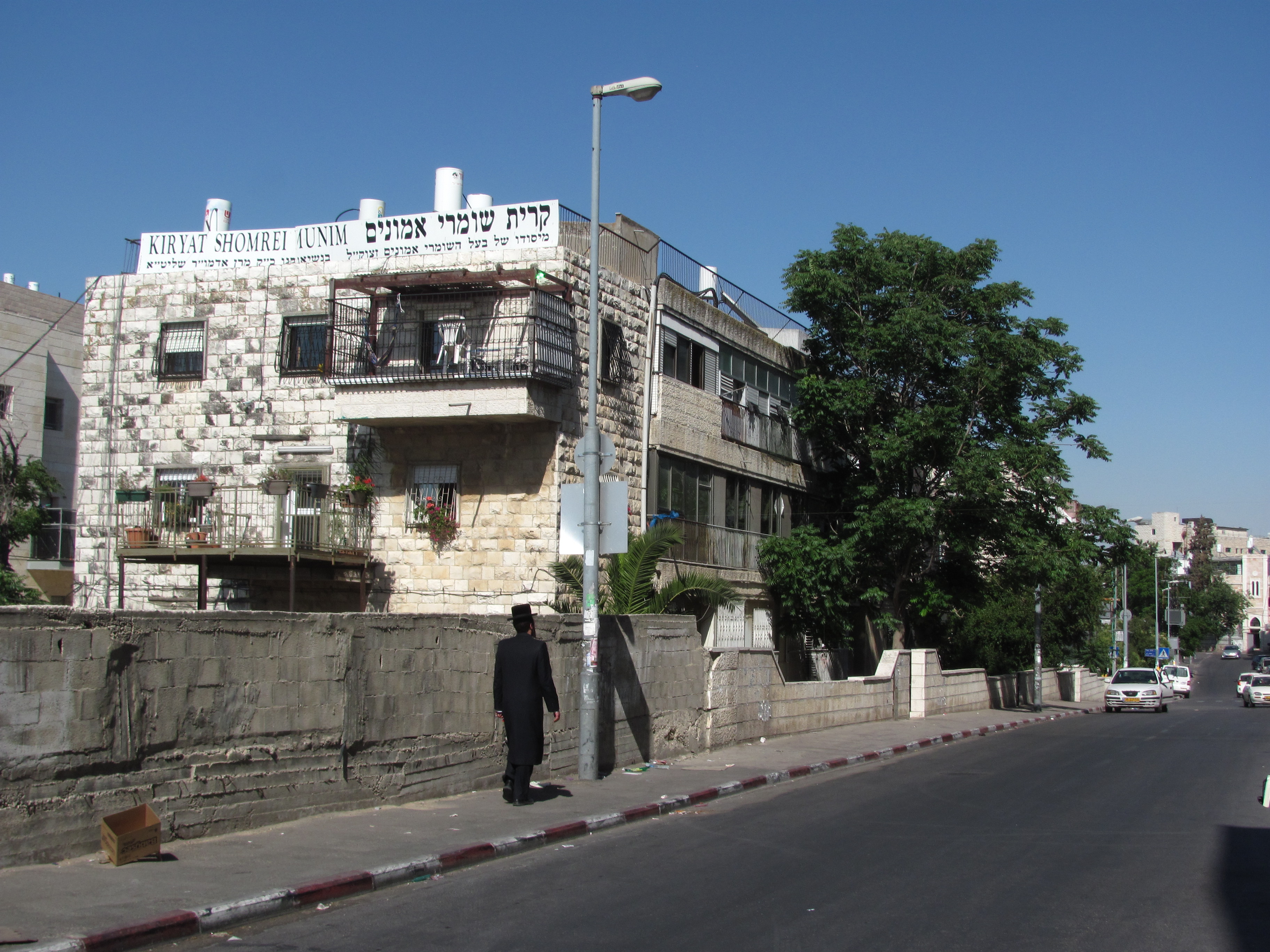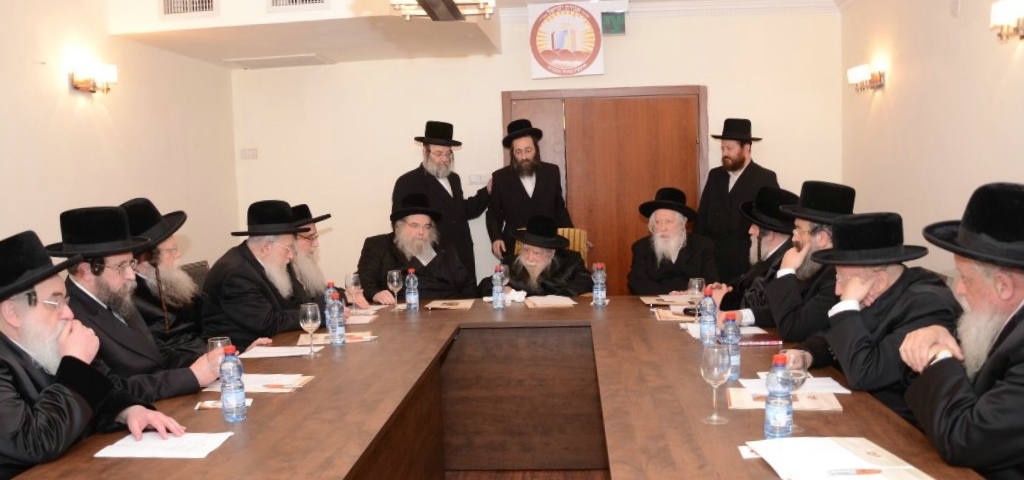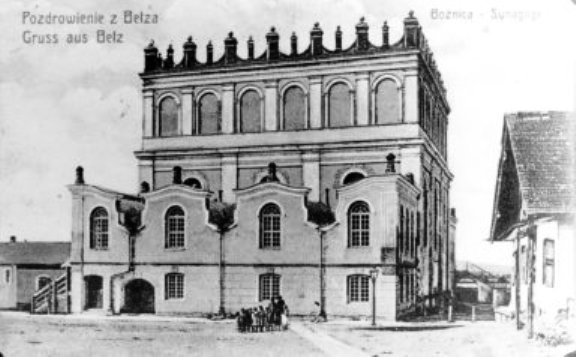|
Shomer Emunim
Shomer Emunim ( he, שומרי אמונים, meaning "Guardian of the Faith") is a devout, insular Hasidic group based in Jerusalem. It was founded in the 20th century by Rabbi Arele (Aharon) Roth. The Shomrei Emunim are characterized by fervent and visibly emotional prayer, and by a rigid lifestyle controlled largely by "''takanos''", decrees written by the Rebbe. One such decree, for example, forbade wearing wool. (Jewish law forbids wearing anything that contains both wool and linen. Rabbi Aharon worried that it would be safest not to wear wool at all, in order to avoid the possibility of violating the law altogether.)See Sefer Takanos v'Hadrochos. Dynastical history and divide Grand Rabbi Aharon Roth, or Reb Arele (as his Hasidim sometimes call him, affectionately), was known to pray especially fervently. According to one story, he regularly had to change his clothes twice during the Sabbath morning service. While the normal service might be two or three hours long, Rabbi A ... [...More Info...] [...Related Items...] OR: [Wikipedia] [Google] [Baidu] |
Aharon Roth
Aharon Roth or Aaron Rote ( he, אהרן ראטה) known as Reb Arele (1894−1947), was a Hungarian Hasidic rebbe and Talmudic scholar. He first established a Hasidic community he called Shomer Emunim (Guardian of Faith) in the 1920s in Satu Mare and in the 1930s in Berehovo, before he settled in Jerusalem, where he also founded a Hasidic community of the same name. His main work is the two-volume ''Shomer Emunim'', written in 1942 in reaction to the news about the Nazi atrocities in Eastern Europe. After his death, the sect split into two groups. One, who adopted the name Shomrei Emunim, followed his son, Rabbi Avrohom Chayim (1924 - 2012), the other followed his son-in-law and became known as Toldot Aharon (Generations of Aharon) of which the Toldot Avrohom Yitzchok later split off. Life Roth was born in Ungvar, Hungary, today Uzhhorod in Ukraine, an outsider to the Hasidic world. He was unusually pious and ascetic from an early age. Until the age of 20, he studied Talmud ... [...More Info...] [...Related Items...] OR: [Wikipedia] [Google] [Baidu] |
Vayoel Moshe
''Vayoel Moshe'' ( he, ויואל משה) is a Hebrew book written by Rabbi Joel Teitelbaum, founder of the Satmar Hasidic movement, in 1961. In it, Teitelbaum argues that Zionism is incompatible with Judaism. As Teitelbaum explains in the introduction, the book's title is taken from the biblical verse of Exodus 2:21, and hints to Teitelbaum's first name (Yoel), and to his grandfather, Moshe Teitelbaum. The verse, which states, "And Moses agreed to stay ... an alien in a foreign land", hints to Teitelbaum's conclusion that the Jewish people should remain in exile. The book is considered to be Teitelbaum's ''magnum opus'', and is of the utmost importance to Satmar Hasidim, as well as to other Haredim who follow the Satmar doctrine regarding Zionism. Satmar Hasidism has many institutions, buildings, and neighborhoods named after the book. ''Vayoel Moshe'' is primarily a book of Halacha, Jewish law. However, it draws on Rabbinic Jewish philosophy as well. Structure The book cons ... [...More Info...] [...Related Items...] OR: [Wikipedia] [Google] [Baidu] |
Edah HaChareidis
The Charedi Council of Jerusalem ( he, העדה החרדית, ''haEdah haCharedit'', Ashkenazi pronunciation: ''ha-Aideh Charaidis'' or ''ha-Eido ha-Chareidis''; "Congregation of God-Fearers") is a large Haredi Jewish communal organization based in Jerusalem, with several thousands affiliated households. It is led by an independent rabbinical court, chaired by the Gaon Convenor, acronymed ''Ga'avad'', and operated by the Rabbi Convenor, ''Ra'avad''. The Council provides facilities such as dietary laws supervision, ritual baths, a Sabbath enclosure, and welfare services. The Council was founded in 1921 by devout Ashkenazi residents of Jerusalem, especially of the Old Yishuv, who refused to be affiliated in any way with the new Zionist institutions. Inspired by militant anti-Zionist ideology, it refuses to receive any state funding from the Israeli authorities, or to endorse voting in the elections, relying on donations from fellow anti-Zionist Haredi Jews abroad and its own incom ... [...More Info...] [...Related Items...] OR: [Wikipedia] [Google] [Baidu] |
Kiryat Shomrei Emunim
Kiryat Shomrei Emunim ( he, קרית שומרי אמונים, "City of the Guardians of Faith") is a Hasidic Jewish neighborhood in western Jerusalem. It was founded in the early 1960s by the Shomrei Emunim Rebbe, Rabbi Avrohom Chaim Roth. Name The neighborhood is named after the eponymous book by Aharon Roth, founder of the Shomer Emunim Hasidic dynasty. This work contains essays on the subjects of "faith, reward and punishment, redemption, and a passionate yearning for God". The main street in the neighborhood is also called Shomrei Emunim Street. Location Kiryat Shomrei Emunim is bordered by Mea Shearim to the south, Beit Yisrael to the west and north, and Shivtei Yisrael Street to the east. History Kiryat Shomrei Emunim was established in the early 1960s by Rabbi Avrohom Chaim Roth, the Shomrei Emunim Rebbe, son and successor of the founder of the Shomer Emunim dynasty, Aharon Roth. The Rebbe selected a site between the long-established neighborhoods of Mea Shearim and Beit ... [...More Info...] [...Related Items...] OR: [Wikipedia] [Google] [Baidu] |
Shneur Zalman Of Liadi
Shneur Zalman of Liadi ( he, שניאור זלמן מליאדי, September 4, 1745 – December 15, 1812 O.S. / 18 Elul 5505 – 24 Tevet 5573) was an influential Lithuanian Jewish rabbi and the founder and first Rebbe of Chabad, a branch of Hasidic Judaism, then based in Liadi in Grand Duchy of Lithuania and later in the Grodno Governorate of the Russian Empire. He was the author of many works, and is best known for '' Shulchan Aruch HaRav'', '' Tanya'', and his ''Siddur Torah Or'' compiled according to the ''Nusach Ari''. Zalman is a Yiddish variant of Solomon and Shneur (or Shne'or) is a Yiddish composite of the two Hebrew words "shnei ohr" (שני אור "two lights"). Zalman of Liady is also known as "Shneur Zalman Baruchovitch," Baruchovitch being the Russian patronymic from his father Baruch, and by a variety of other titles and acronyms including "Baal HaTanya VeHaShulchan Aruch'" (Author of the Tanya and the Shulchan Aruch), "Alter Rebbe" ( Yiddish for ″Old Rabbi� ... [...More Info...] [...Related Items...] OR: [Wikipedia] [Google] [Baidu] |
Strashelye (Hasidic Dynasty)
Strashelye was a branch of the Chabad school of Hasidic Judaism, named after the town Strashelye (Starasel'lye) in the Mohilev Province of present-day Belarus, where its leader lived. Like all Hasidism it is based on the teachings and customs of '' Chasidut'' as taught by the Baal Shem Tov, in turn based on the Kabbalistic works of Rabbi Isaac Luria (also known as the ''Arizal''). The first Rebbe The first Rebbe of Strashelye was Rabbi Aharon HaLevi Horowitz, a student of Rabbi Shneur Zalman of Liadi (1745-1812), the founder of the Chabad Chassidic school of thought. Rabbi Aaron and the second Rebbe of Chabad-Lubavitch While both Strashelye and Lubavitch considered Rabbi Shneur Zalman to have been the first rebbe of their respective schools, the former considered Rabbi Aharon HaLevi Horowitz to be his successor. The latter consider Rabbi Dovber Schneuri (the oldest son of Rabbi Schneur Zalman) the second rebbe. In as much as that is the case, the Strashelye branch of Chabad C ... [...More Info...] [...Related Items...] OR: [Wikipedia] [Google] [Baidu] |
Agudat Yisrael
Agudat Yisrael ( he, אֲגוּדָּת יִשְׂרָאֵל, lit., ''Union of Israel'', also transliterated ''Agudath Israel'', or, in Yiddish, ''Agudas Yisroel'') is a Haredi Jewish political party in Israel. It began as a political party representing Haredi Jews in Poland, originating in the Agudath Israel movement in Upper Silesia. It later became the Party of many Haredim in Israel. It was the umbrella party for many, though not all, Haredi Jews in Israel until the 1980s, as it had been during the British Mandate of Palestine. Since the 1980s, it has become a predominantly Hasidic party, though it often combines with the Degel HaTorah non-Hasidic Ashkenazi Haredi party for elections and coalition-forming (although not with the Sephardi and Mizrahi Haredi party Shas). When so combined, they are known together as United Torah Judaism. History When political Zionism began to emerge in the 1890s, and recruit supporters in Europe and America, it was opposed by many Orth ... [...More Info...] [...Related Items...] OR: [Wikipedia] [Google] [Baidu] |
Belz (Hasidic Dynasty)
Belz ( yi, בעלזא) is a Hasidic dynasty founded in the town of Belz in Western Ukraine, near the Polish border, historically the Crown of the Kingdom of Poland. The group was founded in the early 19th century by Rabbi Shalom Rokeach, also known as the ''Sar Shalom'', and led by his son, Rabbi Yehoshua Rokeach, and grandson, Rabbi Yissachar Dov, and great-grandson, Rabbi Aharon, before the Nazi invasion of Poland in 1939. While Rabbi Aharon managed to escape Europe, together with his brother Rabbi Mordechai Rokeach, most of the Belz Hasidim were murdered in the Holocaust. Rabbi Aharon re-established the Hasidic community in Israel following World War II. At present Belz has sizable communities in Israel, Western Europe, and the Anglosphere. History The founder of the dynasty was Rabbi Shalom Rokeach, also known as the ''Sar Shalom'', who was inducted as rabbi of Belz in 1817. He personally helped build the city's large and imposing synagogue. Dedicated in 1843, the bui ... [...More Info...] [...Related Items...] OR: [Wikipedia] [Google] [Baidu] |
Bnei Brak
Bnei Brak or Bene Beraq ( he, בְּנֵי בְּרַק ) is a city located on the central Mediterranean coastal plain in Israel, just east of Tel Aviv. A center of Haredi Judaism, Bnei Brak covers an area of 709 hectares (1752 acres, or 2.74 square miles), and had a population of in . It is one of the poorest and most densely populated cities in Israel, and the 5th-most densely populated city in the world. History Bnei Brak takes its name from the ancient Biblical city of Beneberak, mentioned in the Tanakh (Joshua 19:45) in a long list of towns within the allotment of the tribe of Dan. Bnei Brak was founded as an agricultural village by eight Polish Hasidic families who had come to Palestine as part of the Fourth Aliyah. Yitzchok Gerstenkorn led them. It was founded about 4 kilometers (2.5 miles) from the site of Biblical Beneberak. Bnei Brak was originally a moshava, and the primary economic activity was the cultivation of citrus fruits. Due to a lack of land, many of t ... [...More Info...] [...Related Items...] OR: [Wikipedia] [Google] [Baidu] |
Joel Teitelbaum
Joel Teitelbaum ( yi, יואל טייטלבוים, translit=Yoyl Teytlboym, ; 13 January 1887 – 19 August 1979) was the founder and first Grand Rebbe of the Satmar dynasty. A major figure in the post-war renaissance of Hasidism, he espoused a strictly conservative and isolationist line, rejecting modernity. Teitelbaum was a fierce opponent of Zionism, which he decried as inherently heretical. His role as a Jewish community leader in Transylvania during the Holocaust remains controversial. Biography Early life Teitelbaum was born on January 13, 1887. He was the second son of Grand Rabbi of Sighet, Chananyah Yom Tov Lipa Teitelbaum, and his second wife, Chana Ashkenazi. The couple married in 1878, after receiving a special dispensation for him to take a second wife, as his first wife, Reitze – daughter of Rebbe Menashe Rubin of Ropshitz – was unable to bear children. Joel was the youngest child; he had four older siblings. The rabbis of the Teitelbaum family were k ... [...More Info...] [...Related Items...] OR: [Wikipedia] [Google] [Baidu] |







.jpg)